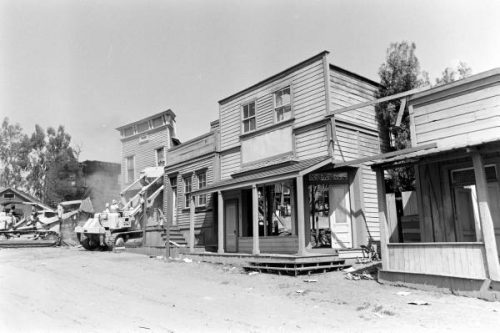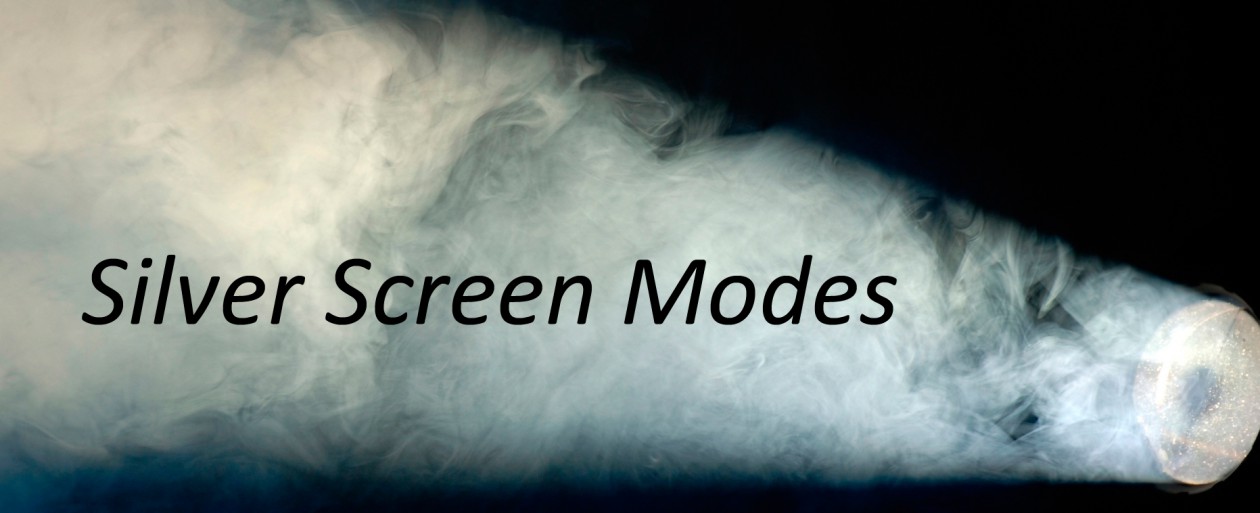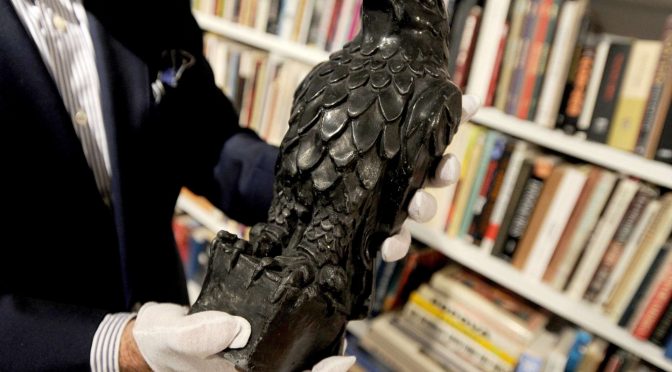Collecting and preserving movie memorabilia is like bottling the river of time. Even the best efforts are fragmentary while the flows continue by. The movie studios themselves made little or no effort in the first decades of movie-making, considering its material objects worthless unless they could be re-used for another production or rented out. To that end “Prop” warehouses on the studio lots began filling up with the furniture and decorative objects needed to decorate a set. This would even extend to horse carriages, wagons, and stage coaches, and the antiques needed for period movies. And weapons too. Costumes would also be stockpiled in the wardrobe department. There was no regard for saving items like scene or set designs, blueprints, costume sketches, or costumes. The paper items were of no value once the film was made and distributed. The wild Jazz-Age costumes of the 1920s would serve no purpose in the 1930s or 1940s and were just tossed. This cycle was repeated periodically as the costume warehouse became overcrowded. In the MGM Animation Department, as was the case at Warner Bros, cartoon cels once used were scraped clean of ink and paint and re-used. There were also stories of mounds of WB cartoons buried in a land-fill – cheaper than marketing them for sale, it was determined at the time.
One person with foresight was Earl Theisen, the Honorary Curator of Theatrical Arts at the Los Angeles County Museum of History., Science and Art, as it was then known. Theisen began asking the movie studios to donate items of historical value to the Museum of Natural History beginning in 1931. This apparently unique idea brought in some great and very rare objects to the Museum, including: Charlie Chaplin’s “Little Tramp” costume; the original King Kong miniature model; a set design for Citizen Kane; Fred Astaire’s Top Hat dance shoes; Lon Chaney’s make-up kit and wax-cast head; an architectural plan for Mack Sennett’s 1917 studio; and Walt Disney’s 1923 animation stand where he created Mickey Mouse. There is much more. Theisen left in 1939, and moved on to become a photographer for Look magazine, and eventually Hollywood memorabilia would no longer be a collecting focus for the Natural History Museum. Today the Hollywood Collection is overseen by Curator Beth Werling.
The “Silent Era” strength of many of the Natural History Museum’s Hollywood collection is fortunate, as these are very rare materials. Only 25% of the silent films made are estimated to have survived. This is largely due to their nitrate-based combustibility. In 1937, a Film Vault fire at the 20th Century-Fox facility in Little Ferry New Jersey resulting in the loss of most pre-1932 Fox films. A vault fire at the MGM studio in Culver City in 1965 destroyed all of the Metro and Mayer silent films, as well as some notables such as Garbo’s The Divine Woman and London After Midnight.

After this grand but all too brief beginning in collecting movie memorabilia, WW II and the 1940s brought a new era to Hollywood. Just as the economy started rolling again television began competing for the movie audience. The effects were compounded by an anti-trust consent decree that forced studios to divest their theater holdings. The Golden Age of the Hollywood studio system lasted through the 1950s but was on the decline through the 1960s. The old studio moguls were mostly gone as corporations took control. And with a decline in revenues, the precious commodities of movie-making went up for sale. An early indicator was when 20th Century-Fox sold 180 acres of its back lot and standing sets in 1961 – this for the development now known as Century City.

The birth of the individual movie memorabilia collector began with the MGM auction in 1970. This was really eight days of auctions of the crown jewels of MGM props and wardrobe – items as big as the Cotton Blossom steam boat from Show Boat, to as small as the Ruby Slippers from The Wizard of Oz. One notable collector began her obsession that May, 1970 – Debbie Reynolds – who not only bought scores of costumes but the props associated with the background scenes. In fact she tried to buy the entire back lot when those came up for sale later, an unsuccessful effort. She was not the highest bidder at the auctions. One bidder paid $15,000 for the Ruby Slippers. But little did he know at the time that there were several pairs of Ruby Slippers. One of the paid staffers for the auction (held by the David Weisz Co.) had been scouting the MGM Wardrobe Dept. beforehand, and had stolen other pairs. Duplicates or even more copies of a wardrobe item are common as they are made for stand-ins as well as for use in case of rips or tears during a scene. For the Ruby Slippers, variant designs were also made. Pairs occasionally show up at auction where they now fetch over a millions dollars.

Other studios were soon holding their own auctions, including 20th Century-Fox and Paramount. Besides the auctions, items were being tossed out by the studios, which encouraged passionate insiders like the “liberator” of the Ruby Slippers from MGM to take liberties by taking items out the back door. Encouragement came at the MGM auction itself as stock wardrobe costumes were sold for $2.00 a piece or by the truck-load for rental houses as Halloween costumes. After 1969 when Kirk Kerkorian bought controlling interest in MGM, the grand old studio would sink to new lows. In addition to the props and wardrobe auctions, several back lots with their standing sets where countless classic movies were filmed were sold for housing developments. Over the following years memorabilia such as music scores, screen tests, and architectural plans were tossed. Kerkorian was more interested in MGM for its name, which he used for his new hotel in Las Vegas. Apparently “truckloads” of MGM memorabilia such as costume sketches, movie photos, and other items were put up for sale at the MGM Grand’s gift shop, or used to decorate the hotel. Debbie Reynolds’ futile effort to save MGM’s legacy went for naught. All that she bought and saved, hoping to either establish her own museum or have one launched in Hollywood, never happened in her lifetime. Most of her outstanding collection – never to be duplicated – was scattered to the winds in a series of auctions starting in 2011.

Today things have changed. Beginning with the MGM auction in 1970 and with the Debbie Reynolds auction of 2011, Hollywood movie memorabilia has become vary valuable. This has gotten the attention of the studios, who have now launched their own archives and museums. The Walt Disney and Warner Bros. companies were in the vanguard on this. Disney because they were lucky in having librarian Dave Smith hired to organize Walt Disney’s office in 1970 four years after Disney’s death. Smith would become the company archivist over the next 40 years. Warner Bros. donated their archives to USC in 1977, under the management of the School of Cinematic Arts. They also launched a museum in 1996. They got serious about preserving and organizing their costume collection and memorabilia collection when in 2000 they lost a lawsuit against John LeBold. He was a Hollywood memorabilia collector and “curator” for Debbie Reynolds who was stealing costumes from Warner Brothers’ wardrobe and selling them. WB did not prevail in their law suit because, among other things, WB’s record-keeping on their ownership of the costumes was “sloppy or non-existent.” The charges were dropped after LeBold returned most of the costumes, including some he had taken from Debbie Reynolds.
Several auction houses have become specialists in “Entertainment” memorabilia. Christie’s and Sotheby handled movie memorabilia among their myriad other objects, but it was Julien’s, Heritage, Bonham’s, and Profiles in History that made a specialty of the field. Julien’s and Profiles in History have in particular staked out movie memorabilia. The early Profiles Hollywood catalogs from the late 1990s/2000 were about 100 plus pages long. Catalog 96 from December 2018 had 600 pages. Needless to say, those early catalogs also had very low prices. But there’s nothing like today’s high prices to shake out more collectibles from the tree.
High movie memorabilia prices has caused several outcomes – not just thick auction catalogs. For one, the studios are saving the best of the classic materials as well as much that’s coming from the new productions. The other is that independent productions are selling off their props and costumes as soon as a movie wraps – another source of revenue for some of the more popular movies. But another outcome is that some of the props, especially for the popular super-hero, science-fiction, fantasy or horror genres are being made in quantity so that more can be sold as the “original” item, usually unknown to the movie’s producer or prop-shop’s owner. Such “fakes” are not just made for new movies. The high prices set for Golden Age movie star costumes and costume sketches has encouraged these pieces of Hollywood memorabilia to be faked and forged as well. As always, let the buyer beware.*
Notwithstanding that comment, memorabilia collectors were in the forefront of gathering and preserving rare artifacts of Hollywood’s past. In addition to them and the studios, one of the museums in Hollywood has set out to preserve an important part of Hollywood history: the original Lasky-DeMille Barn. It was leased by these fathers of Hollywood film making for their production of The Squaw Man which was was made there in 1914. Hollywood Heritage manages the museum where other memorabilia can be viewed by the public. The Academy of Motion Pictures Arts and Sciences established a library in 1928, now the Margaret Herrick Library in Beverly Hills which contains research books, scripts, letters, scrapbooks, set designs, costume sketches, and production files and other items. Located within the Fairbanks Center for Motion Picture Study, tens of thousands of photos and posters can also be found there. But the big news is the forthcoming Academy Museum of Motion Pictures, set to open in late 2019. This is the museum that has been planned by the Academy for many years. It is located on the intersection of Wilshire Blvd. and Fairfax in Los Angeles, in the Los Angeles County Museum of Art campus. It will have Hollywood movie memorabilia in its collections, but these have largely been developed over the last few years (except for items already at the Herrick). The plan for “Opening Day” is to have a two-floor “permanent” exhibit tentatively titled, “Where Dreams Are Made: A Journey Inside the Movies.” Other temporary exhibits will celebrate filmmakers and films and the Oscar experience.
Hollywood memorabilia has come a long way since it was just dumped as useless baggage or sold at garage sale prices (but don’t give up on the latter). If only Debbie Reynolds could have gotten her wish years ago.
*I have found Profiles in History to be very responsive when I have had the occasion to notify them that a costume sketch did not look genuine. I can’t say the same for Christie’s in London.


.look for bed used in gunfight at o.k. coral with Burt Lancaster and Kurt Douglas.
My brother who is into making amateur homemade films is looking to purchase vintage movie props for sale as he told me last Monday over dinner. I offered to help him look into it as well and luckily for him, I found your amazing and informative article here. I am most fond of where you highlighted that high movie memorabilia prices has caused several outcomes – not just thick auction catalogs. A great point indeed, where I’m sure those like my brother will be glad to have known of. Thanks for this! I’ll be sure to share this with him in a bit!
I’m glad my blog post was interesting to you and may be of potential interest to your brother. Since I wrote this, the auction house Profiles in History has ceased operations,
and its owner has joined Heritage Auctions in Dallas Texas. Heritage had also dealt in Hollywood memorabilia, but now they have strengthened their offerings in the line of what Profiles had offered.
Happy hunting.